Charleston Crisp-Crusted Crab Pilau
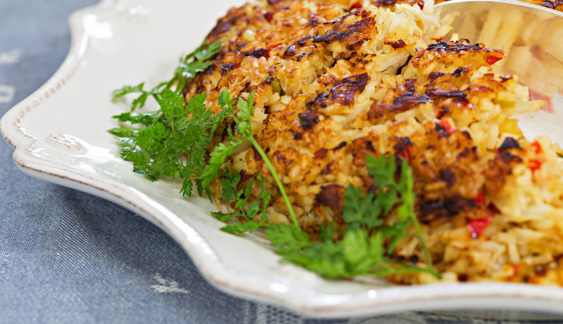
introduction
In Charleston, the term “pilau” (pronounced PUR-loh on location) describes any number of crisply contoured rice casseroles associated with white tablecloth celebrations and a high guest count. In times gone by, a pilau was cooked in three-legged upright cast- iron pot or potje over open flames and inverted—with difficulty, one imagines—onto a platter at the center of the table where it sat splendidly with its long, leggy rice spoon companion. The idea behind inversion was to showcase the outer burnish, while the long handle of the spoon allowed for self service without having to move the rice platter or having someone else serve you rice; the spoon’s deep bowl made excavation of both the crisp outer layer and moist grain-for-grain inner kernels simultaneously accessible. A Charleston pilau is more than simply rice, of course. It features game or seafood, as well as stock and aromatics that enhance those additions. We have been reluctant to tackle this old traditional dish owing to its unwieldiness, to say the least. But tackle it we did, for summer, with crab.
Using proper cookware and a measure of boldness with high-heat, you will produce and unmold a diminutive (serves four to six), but grand, version of the fabled Charleston pilau. You will discover that the dual demands of crisp and soft rice have been achieved, that an elegant fish stock fortified with Pernod has been suffused into each kernel, and that the sweet crab meat—which rolls onto the fork with the rice—is heightened by aromatics redolent of a seaside garden and the fragrance of wild bay.
Cooking Remarks
If you can locate cooked crab legs at a reasonable price, you’ll be able to enhance the flavor of the pilau by making crab-fortified fish stock. Hack 1 pound of cooked crab legs into rough 4-inch pieces and put them into a large saucepan. Pour in 20 ounces (2¼ cups) of Aromatic Fish Stock and 16 ounces (2 cups) of spring or filtered water and bring to a boil over medium-high heat. Cover partially, turn down the heat to medium-low, and simmer for 1 hour. Strain the liquid. You should have 14 ounces (1¾ cups) of crab-fortified stock; if you have more, return the liquid to the saucepan and simmer until reduced to the correct amount.
There are both high and low heats in this recipe. Each is important to the recipe’s success.
For the over/under cooking (stovetop to oven) we cannot fault Le Creuset’s 1½-quart cast-iron brasier. It can take the punishment of high heat and still clean up to a high polish.
equipment mise en place
For this recipe, you will need a medium bowl, a 1½-quart enameled cast-iron braiser (see Cooking Remarks), a small saucepan, a large fine-mesh strainer, a heavy-bottomed medium saucepan, a large skillet, a heatproof rubber spatula, two oven mitts, a small offset spatula, and a rimless platter for serving.
-
-
1pound fresh lump crab meat
-
2tablespoons juice from 1 juicy lemon
-
14ounces (1¾ cups) Aromatic Fish Stock or crab-fortified fish stock (see Cooking Remarks)
-
10.5ounces (1½ cups) Anson Mills Carolina Gold Rice
-
2ounces (4 tablespoons) unsalted European-style butter
-
2Turkish bay leaves
-
1½teaspoons finely grated lemon zest
-
0.5ounces (1 tablespoon) Pernod
-
Fine sea salt
-
2.5ounces (½ cup) minced shallots (about 4 medium)
-
3.5ounces (¾ cup) minced celery (about 4 ribs)
-
1(5-ounce) Italian sweet red pepper, seeded minced (3 ounces or ⅔ cup packed)
-
½teaspoon red pepper flakes
-
¼teaspoon curry powder
-
2ounces (¼ cup) Sercial Madeira
-
Freshly ground black pepper
-
Fresh chervil or parsley sprigs to garnish
-
-
Turn the crabmeat into a medium bowl; if there is excess liquid, pour it off and discard. Sprinkle the crabmeat with the lemon juice, toss to combine, and break any large pieces in half using two forks. Cover with plastic wrap and refrigerate until ready to use.
-
Adjust the oven rack to the middle position; place a 1½-quart enameled cast-iron braiser on the rack and set the lid next to it. Heat the oven to 450 degrees. Put the stock into a small saucepan, cover, and warm over low heat. In a large fine-mesh strainer, rinse the rice under cool water until the water runs clear. Shake the strainer to remove excess water and let the grains dry for a few minutes.
-
In a heavy-bottomed medium saucepan, warm 1 ounce (2 tablespoons) of the butter over medium heat. Add the rice and stir the grains until well coated with fat. Cook, stirring frequently, until the rice is opaque, about 5 minutes. Add the hot stock, bay leaves, lemon zest, Pernod, and ½ teaspoon of salt; stir to combine (fig. 3.1). Increase the heat to medium-high and bring to a simmer, and then decrease the heat to medium-low, cover the pan, and cook for 8 minutes, until the rice has absorbed the liquid. Do not open the lid during this time! Remove the pan from the heat and let stand for 1 minute.
-
While the rice is cooking, in a large skillet, warm 0.5 ounce (1 tablespoon) of the butter over medium heat. Add the shallots, celery, and ¼ teaspoon of salt and cook, stirring frequently, until the vegetables are softened and fragrant, 3 to 5 minutes; do not allow them to color. Add the sweet pepper, red pepper flakes, and curry powder and sauté until the pepper is tender (fig. 4.1), about 2 minutes. Add the Madeira and simmer until it is reduced to a glaze, 1 to 2 minutes. Turn the crabmeat into the aromatics and carefully fold with a heatproof rubber spatula until the crabmeat is warmed through. Now turn the hot rice into the skillet and fold until well combined (fig. 4.2). Taste for seasoning, adding additional salt if needed and seasoning to taste with black pepper.
-
With your hands protected by oven mitts, quickly pull the hot braiser out of the oven and set it on a burner at medium heat if your stove is powerful or medium-high if it is timid. Drop the remaining 0.5 ounce (1 tablespoon) of butter into the pan and swirl to coat the sides and bottom; the butter will sputter and brown slightly. Spoon the rice mixture into the pan without delay, mounding it slightly in the middle, and then press down and smooth the surface with a small offset spatula (fig. 5.1); this process should take no more than 1 or 2 minutes. Slide the braiser into the oven and cover with the hot lid. Bake for 10 minutes, until the rice is tender and the bottom of the pilau is browned and crisp.
-
Remove the braiser from the oven, uncover, and allow to stand for a couple of minutes. Invert a rimless platter over the pan; holding the two together with oven-mitted hands, invert the pilau onto the platter, and then carefully lift off the pan. Garnish with chervil or parsley sprigs and serve (fig. 6.1).
-
-
3.1
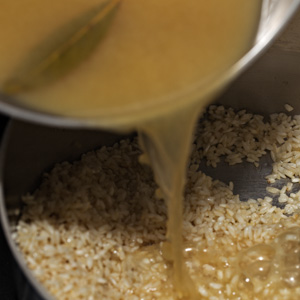
-
-
-
4.1
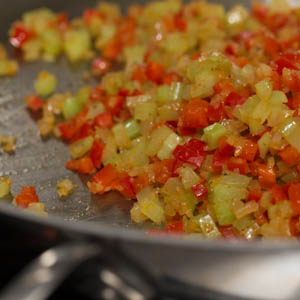
-
4.2
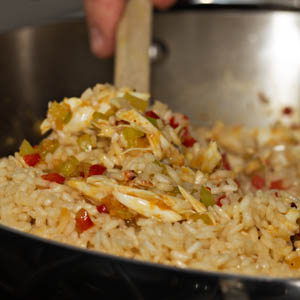
-
-
-
5.1
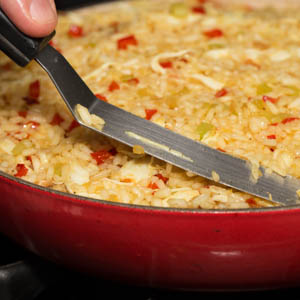
-
-
-
6.1
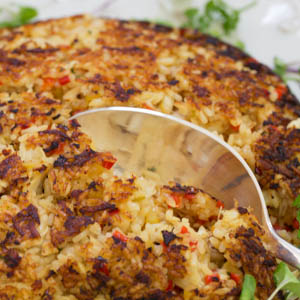
-